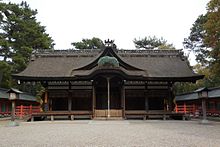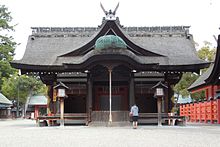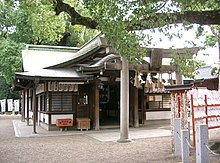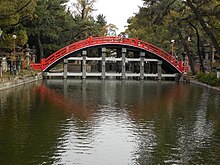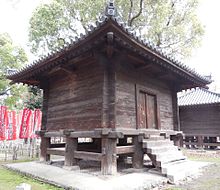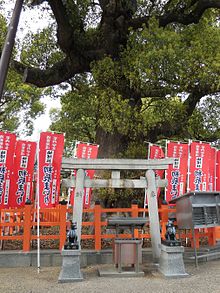Sumiyoshi Taisha
The Sumiyoshi Taisha ( Japanese 住 吉 大 社 ) is a Shinto shrine in the Sumiyoshi district of Osaka , Japan . It is considered the main shrine of over 2,000 Sumiyoshi shrines across Japan that worship kami who are believed to protect travelers, sailors, fishermen and traders. It was probably built in the 3rd century and is already mentioned in the Kokin-wakashū .
Overview
In ancient times, the shrine had a very large area. so in the west belonged the area of today's Sumiyoshi Park, which is now separated by a railway line running in north-south direction. The west-east running pilgrimage route ( Sandō ) began at the sea and extends for a few kilometers to the central facility. Today's shrine area is just under 1 hectare in size. Behind the large torii on the western edge there is a park-like area, then a wide moat, followed by the numerous buildings of the shrine.
The central area
In the central area of Sumiyoshi Taisha, the Sumiyoshi no Ōkami , also called Sumi no E no Ōkami ( 住 江 大 神 ) or Sumi no E no Mimae mo Ōkami ( 墨 江 三 前 大 神 ), are venerated:
- in the 1st main shrine (1st Hongū) Sokotsutsu no O no Mikoto ,
- in the 2nd main shrine Nakatsutsu no O no Mikoto and
- in the 3rd main shrine Uwatsutsu no O no Mikoto .
- In the 4th main shrine Okinagatarashi-hime no Mikoto is venerated, the mythical emperor consort Jingū -kōgō, who is said to have built the shrine after her return from Korea. The bunrei issued by the shrine (see shintai ) always apply to all kami together.
The four shrines each consist of two buildings. The front, transverse building, the prayer hall ( Haiden ) is based on the style of the Buddhist temple architecture of the Momoyama and Edo periods. The rear building, the main hall ( honden ) in white ( gobun ) and red ( tan ), on the other hand, is executed in the architectural style characteristic of this shrine, the sumiyoshi-zukuri ( 住 吉 造 ), one of the oldest shrine architectural styles. The entrance is at the front, in contrast to the Taisha-zukuri of the Izumo Taisha in the middle of the front. The gable beams ( Chigi ) of the main halls 1–3 are cut vertically at the ends, as male deities are worshiped, those of the 4th main hall are accordingly horizontal. The buildings are covered with tree bark, the ridge is weighted down with short crossbeams, the katsuogi . They have a square cross-section, while on other shrines they are round. The main halls are surrounded by fences. The prayer hall of the 1st main shrine is five ken wide, the prayer halls of the other three with three ken are slightly smaller.
The four main shrines face the inland sea , with shrines 3 to 1 standing one behind the other, for which there is no other example in Japan. The main halls were declared a national treasure of Japan on November 14, 1953 .
As is known for other shrines, the main shrines were replaced by identical new buildings every 20 years; for the Sumiyoshi Taisha this is documented from 749. Until 1443 this Shikinen Sengū was actually performed every 20 years, after which it was carried out at longer intervals. The last, 49th renewal was carried out in 2008-2010.
The side shrines
Four secondary shrines, the Sessha ( 摂 社 ), complement the main shrines .
- Daikai Shrine ( 大海 神社 , ~ -jinja ): Toyotama-hiko no Mikoto and Toyotama-hime no Mikoto , who play a role in the legend of Umisachi-hiko and Yamasachi-hiko, are worshiped. The shrine, executed in the Sumiyoshi style, is registered as an important cultural asset of Japan .
- Shiga Shrine ( 志 賀 神社 , ~ -jinja ): Sokotsuwatatsumi no Mikoto , Nakatsuwatatsumi no Mikoto and Uwatsuwatatsumi no Mikoto , who are connected to the sea, are worshiped . There is a torii in the haiden , which is very unusual (usually torii are outside the buildings).
- Funetama Shrine ( 船 玉 神社 , ~ -jinja ): Torinoihakusubune no Kami (a child of Izanagi and Izanami ) are worshiped under the names Amenotorifune no Mikoto and Saruta-hiko no Kami , who protect boats.
- Wakamiya Hachimangū ( 若 宮 八 幡 宮 ): Ōjin Tennō and Take no Uchinosukene , who are considered protective gods of the samurai, are worshiped . A festival will be celebrated on January 12th.
The sub-shrines (Massha)
The sub-shrines, the Massha ( 末 社 ), are partly on the shrine area (marked with [a] in the list), partly outside (marked with [b]).
- Nankun-sha ( 楠 珺 社 ) [a]: Ukanomitama no Mikoto is worshiped . His feast day is the first day of the dragon ( 辰 の 日 , Tatsu-no-Hi ) of the month, so it is also called Mr. Dragon ( 辰 さ ん , Tatsu san ). On this day, those praying receive a cat ( 招福 猫 ) inviting happiness , which brings happiness for 48 months under the name Forty-Eight Dragons . The holy camphor tree next to the shrine, which is estimated to be 1000 years old, is declared a tree worthy of protection in Osaka City.
- Tanekashi-sha ( 種 貸 社 ) [a]: Ukanomitama no Mikoto is worshiped . Originally adored as a helper in agriculture, he turned into a helper in trade. On the first day of the dragon, small coins or dolls are offered to him.
- Ōtoshi-sha ( 大 歳 社 ) [b]: A son of Susanoo no Mikoto , Ōtoshi no Kami , is venerated, and is venerated as a helper in increasing money. For example, on the First Day of the Dragon, prayer is made on Tanekashi-sha for capital growth, on Nankun-sha for good trading, and on Ōtoshi-sha for collecting money. These shrines go well with the merchant town of Osaka.
- Asasawa-sha ( 浅 沢 社 ) [b]: Ichikishimahime no Mikoto , also popularly called Benten- sama, is worshiped . She is an assistant in the field of fine arts. The name of the shrine refers to a humid area at the Sumiyoshi shrine, Asasawa-ono or Asasawa-numa , which is already celebrated in Man'yōshū because of its irises.
- Omoto-sha ( 侍者 社 ) [a]: Tamomi no Sugune and Ichihime no Mikoto , who are considered to be helpers in growing up and in marriage, are worshiped. There are many request tables ( Ema ) to be found there.
- Shōkon-sha ( 招魂 社 ) [a]: Moromoro no Mitama no Kami are worshiped . The building, which dates from around 1600, was known as the Gomadō des Sumiyoshi Jingū-ji (see below) until the separation of Shintoism and Buddhism in the Meiji period .
- Minato-Sumiyoshi-Jinja ( 港 住 吉 神社 ) [b]: This shrine was built in the 19th century to protect shipping.
- Shukuinton-gū ( 宿 院 頓 宮 ) [b]: Sumiyoshi-Ōkami , Jingū-kōgō and Ōtori-Ōkami are worshiped . Along with the Ōtori Taisha of Sakai , a large procession with Mikoshi is held, which attracts many visitors.
Other massha on the site are:
- Tate-sha ( 楯 社 )
- Hoko-sha ( 鉾 社 )
- Gōdo-sha ( 后土 社 )
- Ichiebisu-sha ( 市 戎 社 ) / Daikoku-sha ( 大 国 社 )
- Koyasu-sha ( 児 安 社 )
- Amago-sha ( 海士 子 社 )
- Tatsu-sha ( 龍 社 ), also Mii-sha ( 御 井 社 ),
- Hassho-sha ( 八 所 社 )
- Shingū-sha ( 新 宮 社 )
- Tachigiki-sha ( 立 聞 社 ), also Nagaoka-sha ( 長 岡 社 )
- Kifune-sha ( 貴 船 社 )
- Hoshimiya-sha ( 星 宮 社 )
- Go-sha ( 五 社 )
- Usuzumi-sha ( 薄 墨 社 )
- Kononushi-sha ( 斯 主 社 )
- Imanushi-sha ( 今 主 社 )
Priesthood and festivals
The priesthood in Sumiyoshi Taisha was hereditary for a long time until the family that had always assumed the office died out. The first priest, Tamo-mi-no-sukune, and his wife, Ichi-hime-no-mikoto, are venerated as kami on the shrine grounds in Omoto-sha.
Many festivals ( Matsuri ) are held by the shrine throughout the year . One of the most famous of these is the Otaue-Shinji ( 御 田 植 神 事 ) for rich harvests on June 14th. According to legend, Jingū Kōgō is said to have instructed the women of Nagato Province to plant rice seedlings on the present site of the shrine. This myth is ritually repeated at the festival of twelve young women with traditional dance and music. The main festival of the shrine on July 31st is Nakoshi no Ōharai Jinji ( 夏 越大 祓 神 事 ). It is one of the most colorful and important in all of Japan. The shrine was an important goal of the "representative pilgrimages" performing Gannin-bōzu during the Tokugawa period . The list of festivals and shrine activities is still long today:
- Sakujitsu-sai ( 朔日 際 ): Every month on the 1st day
- Unohi-sai ( 卯 之 日 際 ): Every month on the 1st rabbit day
- Hatsutatsu-sai ( 初 辰 際 ): Every month on the 1st dragon day
- Jūgonichi-sai ( 十五 日 際 ): Every month on the 15th day
- Kaijō, kōtsū anzen kigan sai ( 海上 ・ 交通安全 祈願 際 ): Every month on the 20th day
- Gantan-sai ( 元旦 際 ): January 1st
- Genshi-sai ( 元始 際 ): January 3rd
- Tōka shinji ( 踏歌 神 事 ): January 4th
- Aoumashinji ( 白馬 神 事 ): January 7th
- Mikechi shinji ( 御 結 鎮 神 事 ): January 13th
- Kigen-sai ( 紀元 祭 ): February 11th
- Kinen-sai ( 祈 年 祭 ): February 17th
- Setsubun-sai ( 節 分 祭 ): February 22nd or 23rd
- Matsumae shinji ( 松 苗 神 事 ): April 3rd
- U-no-ha shinji ( 卯 之 葉 神 事 ): 1st Rabbit Day in May
- Otaue shinji ( 御 田 植 神 事 ): June 14th
- Ōharai shiki ( 大 祓 式 ): June 30th
- Mikoshi-arai shinji ( 神 輿 洗 神 事 ): 3rd Monday and Tuesday of July
- Yoimiya-sai ( 宵 宮 祭 ): July 30th
- Reitai-sai ( 例 大 祭 ): July 31
- Nakoshi-no-Ōharai shinji ( 夏 越大 祓 神 事 ): July 31
- Togyo-sai ( 渡 御 祭 ): August 1st
- Aranigo-no-Ōharai shinji ( 荒 和 大 祓 神 事 ): August 1st
- Kangetsu-sai ( 観 月 祭 ): during the autumn full moon
- Takara-no-ichi shinji ( 宝 之 市 神 事 ): October 11th
- Meiji-sai ( 明治 祭 ): November 3rd
- Niiname-sai ( 新 嘗 祭 ): November 23
- Tenchō-sai ( 天長 祭 ): December 23
- Susuharai-sai ( 煤 払 い 祭 ): December 26th
- Ōharai shiki ( 大 祓 式 ): December 31
- Joya-sai ( 除 夜 祭 ): December 31
Other sights
The high lantern
The high lantern ( 高 燈籠 , Taka tōrō ) once stood out in Sumiyoshi Park in the west of Sanjūgen-bori-kawabata. Together with the Sorobashi drum bridge, it was the symbol of the shrine. In ancient times it also served as a lighthouse. After the Second World War it was dismantled due to a shortage of materials, but rebuilt in reinforced concrete in 1974.
Drum bridge to the shrine
The Soribashi Bridge ( 反 橋 ), also called the Drum Bridge ( 太 鼓 橋 , Taikobashi ), has been known since the Kamakura period . It got its current shape with stone pillars when it was donated by Yodogimi, Toyotomi Hideyoshi's wife, around 1600 . For the Kangetsu-Sai ( 観 月 祭 ) poems are quoted on the bridge during the autumn full moon .
Stone lanterns
There are over 600 stone lanterns ( 石 燈籠 , Ishi tōrō ) on the shrine grounds; they have been donated by different people from all over Japan. Well-known donors are the philosopher and scholar Rai San'yō (1780–1832), the painter and calligrapher Nukina Kaioku (1748–1863), the literary painter Ike no Taiga (1723–1776), Go Saku, the Confucianist Shinogizaki Shōchiku (1781– 1851) and Goi Ranshū (1679–1762), the painter Hagura Katei (1799–1887).
Memorial stones
( 石碑 , Sekihi) At the entrance to Shiokakemichi in Sumiyoshi Park there is a memorial stone with a haiku by Matsuo Bashō , on the shrine grounds a memorial stone with a verse by Shōwa Tennō , a stone with a line by Ihara Saikaku , a literature-related Stone from Nobel Prize Winners Kawabata Yasunari , Shokusanjin and Sekkantō.
Obstetrician Stone
When the pregnant Tango no tsubone , lover of Minamoto Yoritomo , felt labor pains while visiting the shrine, she is said to have given birth to a healthy boy with the help of this stone ( 誕生 石 , Tanjōseki ). That was Shimazu Tadahisa, the founder of the Shimazu clan .
Crescent fir
Between the 1st main shrine and the Wakamiya Hachimangū there is a crescent fir ( 五 所 御前 , Gosho gozen ) within a stone fence. When Jingū Kōgō was looking for a suitable place for a shrine in ancient times, she observed how three white herons ( sagi ) settled in this tree . So she decided to build the shrine on this spot.
Stone stage
This facility, namely the stone stage ( 石 舞台 , Ishibutai ), the dance stage ( 楽 所 , Gakusho ), the south gate ( 南門 , Minami mon ): This facility was built at the request of Toyotomi Hideyori and is in the style of the Momoyama period . The stone stage is one of the three stone stages in Japan .
Book magazine
This book magazine ( 住 吉 御 文庫 , Sumiyoshi O-bunko ) was built in 1727 as a two-story store (Kura) with white walls. He took up the collection of books on the three pilgrimage sites of the Edo period , Osaka, Kyōto and Edo. As Osaka's oldest O-bunko, it contains a collection of 30,000 volumes.
High storage
Two high storages ( 高 倉 , Takakura ) in the Asekura style (or Seirō style), which were used to store shrine treasures, are located behind the 1st main shrine. Not a single nail is used in these log cabin-shaped storages, which can be found at many temples in Nara. The memories here in the Sumiyoshi Shrine are attributed to the Momoyama period.
Chain poem place
The building ( 連 歌 所 , Rengasho ), in which Renga poets met, is said to have been built during the visit of Go-Toba Tennō . In 1614, during the siege of Osaka Castle, it is said to have served as the headquarters for Tōdō Takatora . At the beginning of the Shōwa period, the building was moved behind the shrine administration building.
Traces of Sumiyoshi Jingū-ji
This temple, ( 住 吉 神宮 寺 ), was built in 758 at the request of Emperor Kōken . It was located between the main shrines and the Daikai Jinja and was demolished in the Meiji period as part of the separation of Shintoism and Buddhism. A memorial stone reminds of the temple. The Gomadō under the name Shōkonsha and the western pagoda, now on Kirihata-dera ( Tokushima Prefecture ), have been preserved on the site .
Individual evidence
- ↑ Website of the shrine, history ( Memento of the original from August 21, 2017 in the Internet Archive ) Info: The archive link was inserted automatically and has not yet been checked. Please check the original and archive link according to the instructions and then remove this notice.
Remarks
- ↑ Written 始終 発 達
- ↑ Goma is a ceremony of esoteric Buddhism.
- ↑ The other two stages are in Shitennō-ji (Osaka) and in Itsukushima Shrine (Miyajima).
literature
- Sumiyoshi Taisha Sha-jimusho (Ed.): Sumiyoshi Taisha Ryakki . 2000.
Web links
- Shrine site - Japanese
- Osaka City Information Center - English
- sumiyoshi-zukuri 住 吉 造 in the Japanese Architecture and Art Net Users System - English
- Sumiyoshi torii 住 吉 鳥 居 in the Japanese Architecture and Art Net Users System - English
- Nogami Takahiro: "Sumiyoshi Shinkō" . In: Encyclopedia of Shinto. Kokugaku-in , February 24, 2007 (English)
Coordinates: 34 ° 36 ′ 44.76 " N , 135 ° 29 ′ 24.45" E


